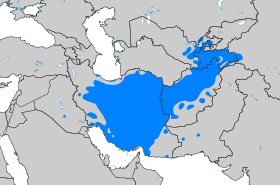فارسى
فارسى (نطق پارسی: [pɒːɾˈsi])، من الفصيله الفرعيه الهند-ايرانيه للغات الهند-اوروبيه. و اكثر عدد من اللى بيتكلموها (مابين 160 لـ 180 مليون واحد) عايشين فى افغانستان و ايران و طاجيكيستان و كذا بلد حواليهم فى الشرق الاوسط. و فيه اعداد كبيره من المهاجرين فى اوروپا و امريكا. الفارسى لغه رسميه فى 3 بلاد: افغانستان و ايران و طاجيكيستان. المؤسسه المسئوله عن دراستها و حمايتها و تنظيمها اسمها ”اكاديمية الادب الفارسي“ (فرهنگستان زبان و ادب فارسی) و مقرها فى طهران.
| ||||
|---|---|---|---|---|
 | ||||
 | ||||
| المتكلمين | ||||
| النسب | | |||
| وكالة الضبط | مجمع لغه وادب فارسى | |||
| ISO 639-1 | fa | |||
| ISO 639-2 | per، وfas | |||
| ISO 639-3 | fas | |||
| لغه رسميه فى | ||||
| الاسم الاصلى | (بالفارسى: فارسی)[9] | |||
| بتتدرس من | علوم الفارسيات | |||
| سبقها | بهلوى | |||
| ازمنه | المضارع فعل ماضى مستقبل مستمر مضارع تام مضارع تام | |||
| الصيغه النحويه | المزاج الحقيقى الصيغه الشرطيه فعل امر دلاله على التمنى | |||
| السكان الاصليين لـ | ايران الكبرى | |||
| نظام الكتابه | حروف فارسى ، وكتابه عربى | |||
| تعديل |
||||
الفارسى بيتكتب بحروف فارسى فى افغانستان و ايران و ينطقون عليها هناك اللغه او اللهجه الدارى) و بيتكتب بحروف كيريلى فى تاجيكستان و روسيا و معروف فى البلاد باسم اللغه او اللهجه التاجيكي.


مثال على اللغه
تعديل| فارسی | همهی جهانیان آزاد زاده شدهاند و در بزرگی و سزامندی با هم برابرند.
آنها از خرد و بینش برخوردارند و باید با یکدیگر برادرانه رفتار کنند. Hameye Jahãniyan Ãzãd zãdeh shodehand va dar Bozorgi va sezãmandi bã ham Barãbarand .Ãnhã az Kherad va Binesh barkhordãrand va bãyad bã yekdigar barãdarãneh raftãr konand |
كل الناس بيتولدو حرين و متساوين فى الكرامة و الحقوق. إتوهبلهم عقل و ضمير و المفروض يعاملو بعض بـ روح الأخوية. |
|---|
— الماده الاولانيه م الاعلان العالمى لحقوق الانسان
شوف كمان
تعديللينكات برانيه
تعديل- الوقت المتاح لتشغيل البرامج النصية قد انتهى.
مصادر
تعديل- ↑ ScriptSource - Iran — تاريخ الاطلاع: 21 اغسطس 2023
- ↑ ScriptSource - Bahrain — تاريخ الاطلاع: 21 اغسطس 2023
- ↑ ScriptSource - Afghanistan — تاريخ الاطلاع: 21 اغسطس 2023
- ↑ ScriptSource - Pakistan — تاريخ الاطلاع: 21 اغسطس 2023
- ↑ ScriptSource - Tajikistan — تاريخ الاطلاع: 21 اغسطس 2023
- ↑ ScriptSource - Uzbekistan — تاريخ الاطلاع: 21 اغسطس 2023
- ↑ ScriptSource - Russian Federation — تاريخ الاطلاع: 21 اغسطس 2023
- ↑ ScriptSource - United Arab Emirates — تاريخ الاطلاع: 21 اغسطس 2023
- ↑ https://github.com/unicode-org/cldr/blob/main/common/main/fa.xml
| ||||
|---|---|---|---|---|
| ||||
الوقت المتاح لتشغيل البرامج النصية قد انتهى.
الوقت المتاح لتشغيل البرامج النصية قد انتهى.











